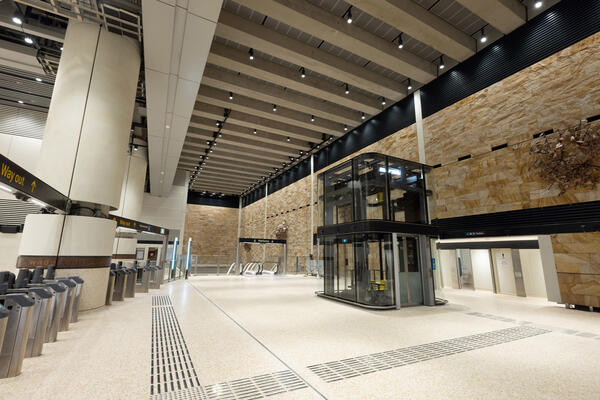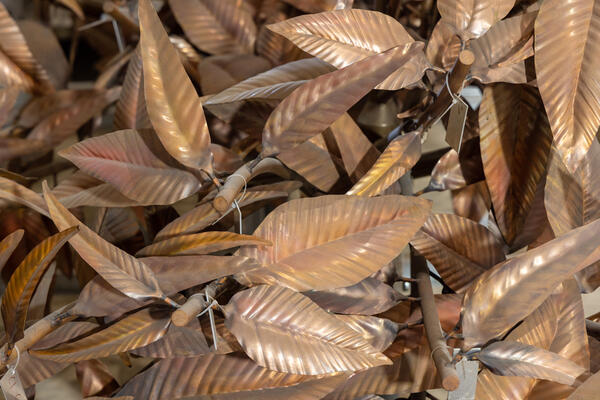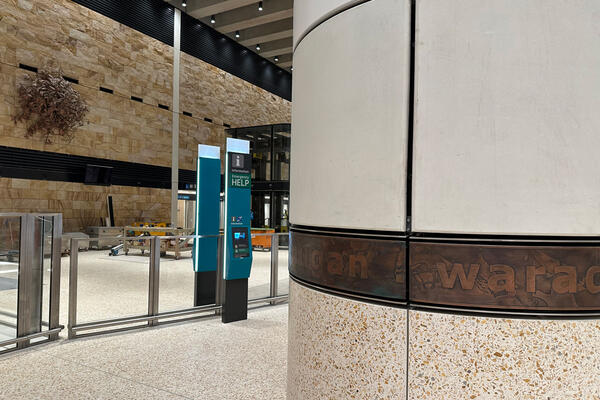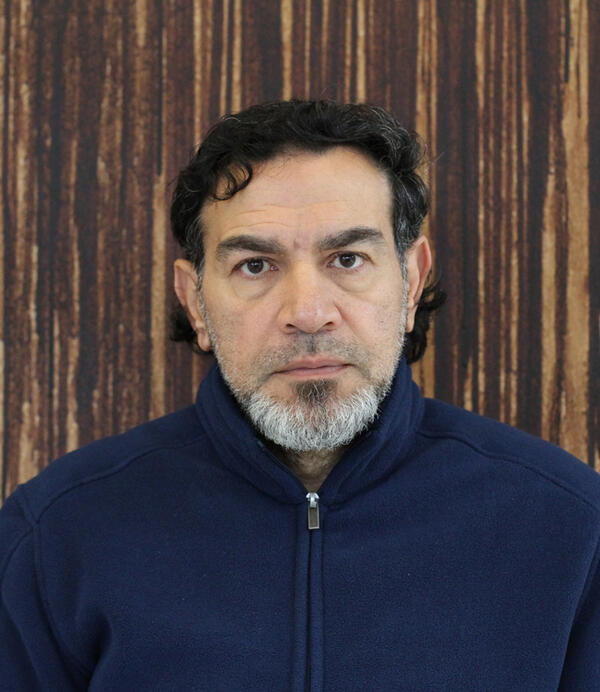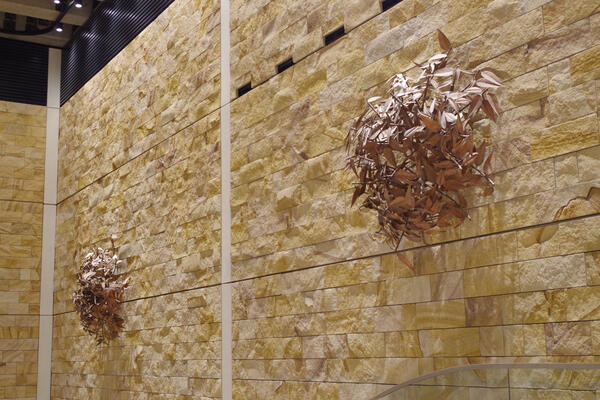
In Time We Shall
Inspired by timeless, universal and cross- cultural philosophies, In Time We Shall connects customers at the new Sydney Metro Barangaroo Station to ancient, shared symbols and the spiritual significance of the tree of life.
Image

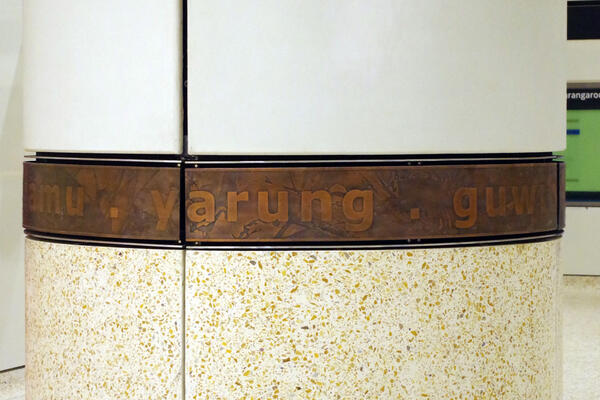
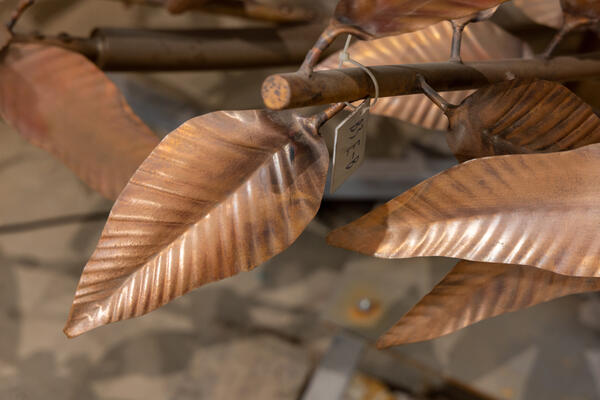
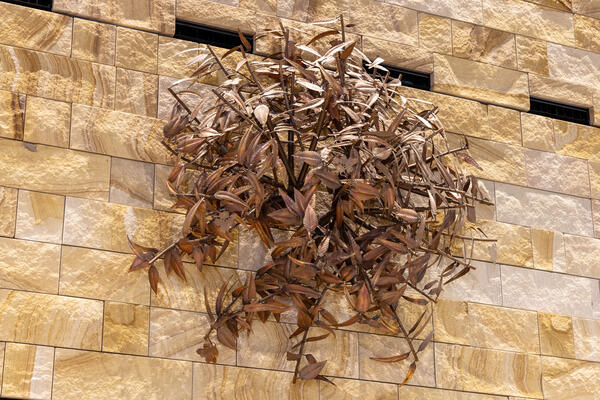
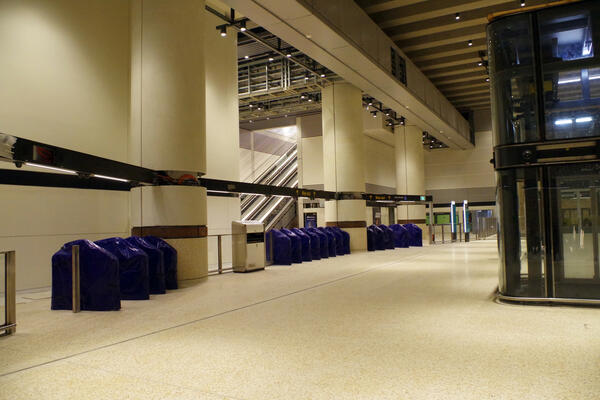
Image controls:
About the artwork
Khaled Sabsabi created In Time We Shall as a landmark feature for the Barangaroo Station entrance. The artwork is an abiding acknowledgment to the traditional and original people of the Sydney basin and the powerful symbol of trees as nurturing life, culture and connection.
There are seven sculptures of trees fabricated from copper and steel which are mounted to the eastern wall, and four bronze bands circling the concourse columns. This artwork is a testament to the original people of the Sydney Basin and the role of trees in nurturing life, culture and connection.
The giant tree crowns emerge from the wall creating the illusion that we are floating above them gazing down. The trees reference the species of endemic trees found in nearby Barangaroo Reserve. They are Forest Red Gum, Sydney Peppermint, Sydney Red Gum, Red Bloodwood, Black Butt, Grey Gum and Spotted Gum.
The four column bands, crafted from bronze, are located centrally in the space and were developed in consultation with the local Aboriginal community. They also describe Sydney basin trees: the Port Jackson Fig, Grey Myrtle, Coast Banksia and Cabbage Tree Palms including their Aboriginal names.
The raised and recessed reliefs on the bands of each column have been three-dimensionally crafted using both machine-pressed and hand-shaped techniques.
Copper, bronze and brass are ancient materials that exemplify the renaissance of art. They also played a major role in the maritime and shipping industries for thousands of years including Barangaroo’s settlement history on the harbour’s edge.
In Time We Shall evokes the universal symbols of the tree of knowledge, which connects the heavens and the earth, and the tree of life, which connects all life forms and is also related to immortality. It embodies traditional and contemporary art movements, including traditional materials and modern technologies, and connects the Eora peoples with contemporary station communities.
Artist Statement
"I am interested in making art that brings people together and am inspired by the social commonality that continues to define and shape us as a diverse and multifaceted society.
In Time We Shall is inspired by timeless, universal, and cross-cultural philosophies relating to and associated with concepts of the trees of life and knowledge.
The trees of life and knowledge are common legends that continue to be relevant across many cultures, maintaining their mystique throughout time and place. It is widely believed that the tree of knowledge connects the heavens and the earth, while the tree of life connects all life forms and is often related to immortality. In other interpretations, they are both regarded as representative cosmic forms that are deeply depicted in diverse sacred teachings, folklore, and traditions.
I see In Time We Shall as a landmark feature for the Sydney Metro Barangaroo Station site, as artworks that are grand and beautiful, meaningful yet accessible, simple yet intricate. Additionally, I see the works as an artistic possibility to engage with and narrate our city’s past and future by poetically considering themes of representation as well as our broader global identity and yet-to-be imagined futures.
Barangaroo's unique parkland reserve has greatly informed the in time we shall concept which utilises the 14 species of trees found in Barangaroo Reserve, including the 12 species that are site-specific and the two tree species that were chosen by the Barangaroo Delivery Authority for their iconic status across the broader Sydney basin environment.
In Time We Shall articulates Barangaroo Station's uniqueness based on place-making connections with the surrounding environment, its heritage, and communities.
The path the artwork takes was intentionally chosen to acknowledge and offer reverence to the Gadigal clan of the Eora nation and broader Dharug communities.
Community and stakeholder involvement throughout helped create a wider sense of ownership with the artwork.
In Time We Shall is located on the middle floor area of the new station, and I have purposely chosen the middle floor as emblematic of the middle ground and the sense of transition, journey, and movement as well as to inspire thought in our ever-evolving multicultural society."
Artist Biography
Born in Tripoli, Lebanon Khaled Sabsabi migrated to Australia with his family as a child in 1976. They settled in Western Sydney where he continues to live and work.
In 2001, Khaled returned to Lebanon and the surrounding region for an extended travel period. This journey became a significant moment in his creative career as he questioned, reflected and redefined his philosophical perspective and contemporary visual arts practice.
In 2005 he completed a Master of Fine Arts degree from the University of New South Wales.
Sabsabi has produced more than 65 major mixed media and installation-based works to date and exhibiting in over 90 solo and group art exhibitions in Australia and abroad.
Sabsabi’s artistic process involves working across art mediums, geographical borders and with communities to create immersive and engaging art experiences. For more than 30 years, he has worked in detention centres, schools, prisons, refugee camps, settlements, hospitals, youth centres, public and private galleries in the Australian and international context.

